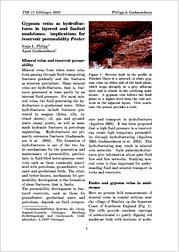Gypsum veins as hydrofractures in layered and faulted mudstones: implications for reservoir permeability
Philipp, Sonja L.
Gudmundsson, Agust
Universitätsverlag Göttingen
Sammelband- / Konferenzbeitrag
Verlagsversion
Deutsch
Philipp, Sonja L.; Gudmundsson, Agust, 2006: Gypsum veins as hydrofractures in layered and faulted mudstones: implications for reservoir permeability. In: Philipp, S.; Leiss, B; Vollbrecht, A.; Tanner, D.; Gudmundsson, A. (eds.): 11. Symposium "Tektonik, Struktur- und Kristallingeologie"; 2006, Univ.-Verl. Göttingen, p. 164 - 167., , DOI: 10.23689/fidgeo-1901.
 |
Dokument öffnen: |
Mineral veins form when water solutions
passing through fluid-transporting
fractures gradually seal the fractures
as minerals precipitate. Many mineral
veins are hydrofractures, that is, fractures
generated at least partly by an
internal fluid pressure. For most mineral
veins, the fluid generating the hydrofracture
is geothermal water. Other
hydrofractures include fractures generated
by magma (dykes, sills, inclined
sheets), oil, gas and groundwater
(many joints), as well as manmade
hydraulic fractures in petroleum
engineering. Hydrofractures are primarily
extension fractures (Gudmundsson
et al. 2002). The formation of hydrofractures is one of the two basic
mechanisms for the generation and
maintenance of permeability, particularly
in fluid-filled heterogeneous reservoirs
such as those commonly associated
with petroleum, groundwater, volcanic
and geothermal fields. The other,
and better-known, mechanism for permeability
development is the formation
of shear fractures, that is, faults.
The permeability development in fractured
reservoirs, such as those for
groundwater, geothermal water and
petroleum, depends on fluid overpressure
and transport in hydrofractures
(Aguilera 1995). It has been proposed
that a high fluid pressure in a reservoir
can create high temporary permeability
through hydrofracturing (Aguilera
1995; Gudmundsson et al. 2002). This
hydrofracturing may result in mineral
vein networks. Such palaeohydrofractures
give information about past fluid flow and flow networks. Studying mineral
veins is thus important for understanding
fluid and mineral transport in
rocks and reservoirs...

